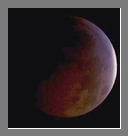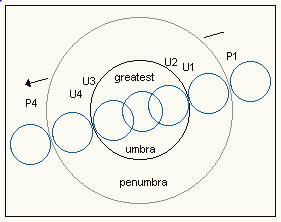
 | a total lunar eclipse is a fine and remarkable sight. picture courtesy NASA/Bill Ingalls |
A Moon eclipse provides for a deep, and even dramatized, sense of such a major astronomical event. From an observational point of view, observing a Moon eclipse (of whatever kind it be -partial or total) does not, like for Sun, requires any special caution nor special techniques of observation (except the question of whether to use or not an usual Moon filter dedicated to usual Moon observation). It may even be observed naked-eye. Binoculars are useful too. When you plan to observe a total lunar eclipse with a instrument, to begin with a 50x magnification is a good start. Technically, the Moon eclipses part between the total (or partial) Moon eclipses, when the Moon is affected, totally, or partially, by the "umbra" of the Earth -the darkest of the Earth's shadow, and the penumbral Moon eclipses (total or partial), when the Moon is affected just by the "penumbra" of the Earth, the lighter part of the Earth's shadow
for more about the theory of the Moon eclipses, see our tutorial 'Moon Eclipses'
| Observing a Total (or Partial) Moon Eclipse | The Case of the Observation of a Penumbral Lunar Eclipse |
We mostly here as describing the observation of a total lunar eclipse, which is one during which Moon is transiting inside Earth's umbra, the darker of the Earth's shadow. During a Moon total eclipse, the Moon endures a penumbral eclipse, a partial eclipse and a total eclipse. A total Moon eclipse unfolds according to this sequence: Moon's east limb comes to contact of the penumbral shadow, that lighter part of the Earth's shadow. That is 'P1,' or first penumbral contact. It then reaches the umbra, which is 'U1,' or first umbral contact as the Moon disk then moves into Earth's main shadow
 | click to theory of the different phases of a Moon total eclipse |
At U2, the west edge of the Moon is in contact with the outer western limit of the umbra; there totality begins. The eclipse reaches its greatest; Moon is at its maximum into the umbra. Then process moves in the reverse: the east edge of the Moon comes into contact with the outer eastern limit of the umbra (U3); the Moon disk leaves the totality. Moon's west edge comes in last contact with the outer eastern limit of the umbra (U4); Moon definitively leaves the umbra. At last, the last penumbal contact occurs (P4); Moon's west edge is in contact with the penumbral shadow eastern limit. Practically, observers should be aware that a Moon total eclipse seen in its entirety is a long event (about 5 hours; about 3 hours 20 mn for the umbral phase) and should organise themselves accordingly (clothes related to weather, cold, etc)
 | click to how the different phases of a Moon total eclipse are seen. pictures bottom with Stellarium |
Then, observation proper depends upon each one: a Moon eclipse may be observed naked-eye, noting the eclipse's unfolding; naked-eye and with binoculars; in a small telescope; visually or photographically; or a variation of these. A good way is too to prepare the observation. Have a look to what is said about the eclipse, its timing, Moon's North, South, East, and West, what stars will be in the field, etc. Then observation will unfold more easily as you will have some marks about what is happening. For details about how a Moon eclipse works, see the tutoriel "Moon Eclipses"
How Moon is turning red by a eclipse's totality was first explained by astronomer Kepler like the passage of sunlight into the lower layers of the Earth's atmosphere. About how Moon's aspect is affected by Earth's umbra, this depends upon the quality of Earth's upper atmosphere at the moment of the eclipse. Major volcanic eruptions usually leave a haze of ash and dust in the atmosphere and provide very dark and vivid eclipses as a clear upper atmosphere produces bright and colorful, coppery and orange-dominated, eclipses. Volcanic particulates are scattering red light in the atmosphere at they allow blue light in. High atmosphere, tropopause pollutants are now considered too like originating from pyrocumulonimbus storms which are thunderstroms weather conditions which funnel upwards particles coming from wildfires below. 17 such storms can be observed yearly in North America as they further whip the fires under them. A lot of clouds leads to dark, dimmer, eclipses. The generally reddish color of the Moon is due to the Sun light grazing Earth's upper atmosphere. The blank light, which is a mix of the rainbow colors, is scattered from its blue component there by aerosols and molecules. Earth's shadow is stretching up to one million miles (1.6 million km) away. Could you fly until about 200,000 miles (320,000 km) from Earth and look back you would see the Earth's upper atmosphere glowing red. Earth seen from Moon is 1° 45' wide
Two special observational records are specific to Moon eclipses: the Danjon's scale (designed by Danjon, a French astronomer) is used to give a value to the brightness and the appearance of the Moon. The official five points scale is:
L values are estimated near mid-totality, naked-eye, in binoculars or a small telescope. Is is also useful to look at the Moon's appearance just after the beginning and before the end of totality (U2, U3), the Moon being at the edge of the umbra and providing a mean to assign a L value to the outer umbra. Attention may be also given to variations in color and brightness in different parts of the umbra and to the apparent sharpness of the umbra's edge. A specific Danjon value may be attributed to the various parts of the Moon as, when the Moon, for example -and which is most often the case- has one limb deeper into the umbra, various shades are seen at the surface. At last one may also observe the sharpness of the Earth's umbra during the penumbral phase, when it is seen increasing upon the lunar surface. The other specific record is related to the assessment of the umbra's radius as it seems to be larger than theoretical value gives it and moreover varies from eclipse to eclipse. The assessment of this shadow enlargement is made with a low power telescope by timing the moments when the most abrupt gradient of the umbra's edge crosses the center of some craters of the Moon (planned timings for these craters are given for each eclipse; actual timing is made for each edge of the craters entering and leaving the shadow -the center crossing being the mean). For more details about these two observation records, see the good site of Fred Espenak, Eclipse Home Page
The show during a total lunar eclipse is not displayed at the Moon only! By the early eclipse, Moon brightness is illuminating the landscape and even is projecting shadows. When the eclipse is well into the one through the umbra, the feeling that a sort of silence is setting into. Then, when the total eclipse unfolds, one can remember the antique terrors that went with such the near-dissapearance of Moon! As Moon gets darker further, stars turn accordingly more visible
 | a total lunar eclipse en cours like a partial. picture courtesy NASA |
At last, let's give these additional data: data of interest which are useful for a Moon eclipse observation -and which are to be found, e.g. on maps of the site of Fred Espenak are the following: the path of Moon's disk through the penumbra and umbra. Diverse data: instant of greatest eclipse; umbral and penumbral magnitudes -fractions of Moon's diameter immersed in the shadows at greatest eclipse; radii of umbra and penumbra; gamma; axis (minimum distances in Earth radii or degrees of Moon center from shadow axis, data about the saros); apparent semi-diameter of the Moon. Data for the eclipse's unfolding: eclipse semi-durations (penumbral phase, umbral phase, total phase) and times in UT for the contacts (P1, time of first exterior tangency of Moon with penumbra, beginning of penumbral eclipse; U1, time of fist exterior tangency of Moon with umbra, partial umbral eclipse begins; U2, time of first interior tangency Moon/umbra, totality begins; and the reverse: U3, U4, P4, end of totality, end of partial umbral eclipse, end of penumbral eclipse). These three first sets of data are the data which are useful to observe and time the eclipse. At last, a map for the visibility of the eclipse (the entirely clear zone is where the eclipse it observable in its entirety; the entirely dark zone is the zone where the eclipse in unobservable. Medium shaded zones are zones where eclipse is observable either at moonrise or at moonset and for diverse stages of the eclipse -from P1 to P4
Partial Moon eclipses are just occulting a part of Moon, as, at the eclipse greatest, the red-orange hues may be possibly seen. Partial lunar eclipses are fine show too however as the Moon is seen indented by the dark "umbra" of the Earth. Observing a partial Moon eclipse is thus of interest too, as the instruments and techniques needed (the Danjon scale excepted) remain the same
Penumbral Moon eclipses -when the Moon is affected by the "penumbra", that area, around the "umbra", where the Earth's shadow is lighter, are hard to observe while the Moon does not journey across the about 3-lunar diameter-wide Earth's dark "umbra" but in the "penumbra" only (hence the name). As seen from the Moon, such a penumbral eclipse would be seen like a partial solar eclipse. That means thus that the dimming of the Moon, as seen from Earth, is weak and that, in no case, a penumbral lunar eclipse is featuring the famed red-hued tints displayed during a total, or partial Moon eclipse. A penumbral Moon eclipse, however, is another show of interest, and worth the observation too. The dimming of the Moon is observable, mainly, at the strongest of the penumbral eclipse and before and after the eclipse's greatest, from when the Moon's edge is either midway in, or out, of the penumbra. The target of the observation is to watch the progress of the dimming, visually, or photographically. A small instrument, or, above all, binoculars, are the easiest way to observe a penumbral Moon eclipse, with the naked eyes useful too. A interesting exercise is to note when penumbral shading is first and last seen. Deep penumbral lunar eclipses -or when the Moon is almost entirely passing into the penumbra- are easily visible to the naked eye as a dusky shading in the concerned halve of the Moon. The beginning and end of a penumbral eclipse are not visible. In fact, no shading can be detected until about 2/3 of the Moon's disk is immersed in the penumbra. Atmospheric conditions and the observer's visual acuity are important factors to consider. Partial penumbral lunar eclipses are theoretically possible, but they are harder to observe. A partial penumbral lunar eclipse occurs when the Moon is just partially transiting in the penumbra of the Earth, at an outer limit of it. Due to such a geometry, the possibility of observing a partial penumbral eclipses just relies on how much the lunar disk is affected by the penumbra. Such eclipses may be worth the observation for training, if not for any other reason
Website Manager: G. Guichard, site 'Amateur Astronomy,' http://stars5.6te.net. Page Editor: G. Guichard. last edited: 11/22/2011. contact us at ggwebsites@outlook.com